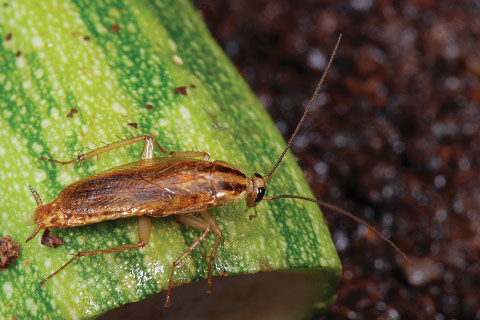Battling Pests in Public Housing
Teamwork and Training Disarm Urban Intruders
 |
|
Can you think like a cockroach? Public housing trainees learn about pest biology and behavior. For example, cockroaches seek warmth, water, and food—and they like to travel in crevices their own height. |
Urban pests like cockroaches and mice can trigger asthma, contaminate food, and damage buildings. They can also cause stress and lead people to misuse pesticides. An IPM approach makes homes less hospitable to pests and selects least-toxic, low-exposure pesticides as a complement to maintenance and pest prevention.
Public Housing Authorities (PHAs) provide affordable housing to more than one million families nationwide, often in areas with high asthma rates where pesticide misuse has been documented. “Delivery of Integrated Pest Management Training to PHAs” is a new project that promotes the use of IPM in these settings.
The biggest challenge of managing pests in public housing is getting cooperation from all of the people who need to be involved. Maintenance staff must repair holes in walls, fix water leaks, and maintain screens. Trash removal contractors must empty dumpsters regularly. Residents must keep their units clean and dry, take out trash, and prepare for the pest management professional’s visit. Resident services must help when residents are unable to do their part. And contracted pest control companies, often considered solely responsible for solving pest problems, must communicate with staff and residents and follow IPM recommendations. IPM in public housing must be a team effort.
To build teams and support a transition to IPM, the Northeastern IPM Center is delivering training programs in cities across the country. An initial “Train the Trainer Training” gets IPM experts involved in the program. These trainers then lead one-day maintenance training sessions for PHA staff and contractors. Finally, residents receive tools they need to do their part and are educated about the roles of the entire IPM team.
“We’re all part of the problem, we’re all part of the solution,” explained a Boston resident after being part of an IPM training session. Acknowledging shared responsibility, one property manager told a resident, “You have to push me to provide better service. I have to hold our pest management provider accountable.”
So far, the maintenance training has been developed by incorporating lessons learned from existing IPM projects and expert advice from the U.S. Department of Housing and Urban Development (HUD), U.S. Environmental Protection Agency, Centers for Disease Control and Prevention, National Pest Management Association, Regional IPM Centers, state IPM programs, private consultants, and organizations such as the National Center for Healthy Housing. All those who collaborated to develop the program will use it as the standard for affordable housing nationwide.
The Northeastern Center’s part in this project, funded by HUD through the USDA, is to deliver the training program to conventional PHAs throughout the four USDA regions. IPM experts and Cooperative Extension staff who are interested in training for this program can contact stoppests@cornell.edu and view the training materials online.
The Northeastern IPM Center promotes integrated pest management for reducing risks to human health and the environment. If republishing our news, please acknowledge the source (“From Northeast IPM Insights”) along with a link to our website.
